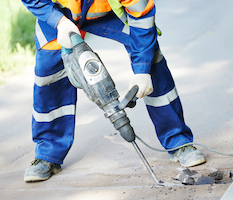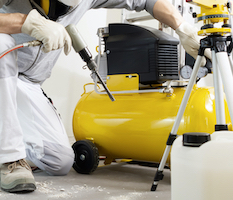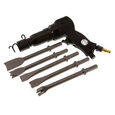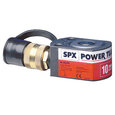Electric & Air Hammer With Chisels


Figure 1: Electric hammer (up) and air hammer (down)
Air and electric hammers are handheld tools used for chiseling. They provide fast, smooth, and accurate cutting compared to conventional manual hammers. Automotive repair, construction, and other industrial applications use air and electric hammers to break concrete or cut metal objects apart. This article explores the construction, working, and applications of an air hammer and an electric hammer.
Table of contents
- What is an air hammer?
- Air hammer parts
- Air hammer applications
- Choosing the right air hammer
- Electric hammer with chisel
- How to install a chisel on an electric hammer
- Choosing the right electric hammer
- FAQs
View our online selection of air hammers & chisels!
What is an air hammer?
An air hammer (Figure 1), also called a pneumatic hammer or an air chisel, is a handheld tool that uses compressed air to drive a chisel. Air hammers are typically universal tools. A user can choose different attachments to suit specific projects. An air hammer can easily fit attachments from other manufacturers.
Air hammer parts
Air hammers are attached to pneumatic valves or air rams attached to a hose leading to a large compressor tank. The tank pumps up air to make the air hammer work.
Piston
A cylinder holds the piston. The piston moves up and down (similar to the up and down motion of the hammer) when the air compressor pumps air into the cylinder. The compressor pushes air into the cylinder forcing the piston tip forward with high velocity. A valve reverses the airflow forcing the tip attachment to the back of the cylinder, and the cycle is repeated.
The drill bit
The drill or chisel bit is a metal bar bit at the bottom of the cylinder. The piston makes contact with the drill bit pushing the latter forward. Chisels used in hammering have thicker and tougher blades to withstand high force. Read our article on chisels for more information on chisel types and their functions.
Air hammer applications
An air hammer outperforms a manual hammer and chisel due to its tremendous speed in doing a job. This tool is suitable for applications that require cutting through a surface, digging a hole, and shaping or smoothening a surface. Typical applications of air hammers are:
- Penetrating solid materials like stone, tile, and concrete and removing heavy materials
- Cutting exhaust pipes and split ball joints and unbolting frozen fasteners and rubber bushings
- Metalworking shops use air hammers to cut, flatten, or shape metals such as structural steel, 10-gauge steel, aircraft-grade aluminum, or copper.
Choosing the right air hammer
Air hammers differ in their power, size, and attachments. Light air hammers are suitable for cutting thinner materials like sheet metals, while heavy-duty hammers are ideal for resistant materials found in automotive work.
Power
The amount of air drawn from the compressor in an air hammer determines the device's power. The value is usually expressed in cfm (cubic feet per minute). A more powerful air hammer consumes more air and has a high cfm figure. Most air hammers require a continuous pressure of 90 pounds per square inch (psi) to work reliably. Examine the air hammer’s cfm and psi figures to ensure it is compatible with the air compressor.
Size and stroke length
Stroke length is the distance traveled by the piston in each cycle, and the value is expressed in inches. The longer the stroke length, the higher the velocity the piston achieves at the end of each stroke cycle, and the more power it can deliver to the chisel. A medium-duty air hammer has a stroke length of ⅝ - 2 inches (15.8 - 50.8 mm). The stroke length can go up to 3 inches (76.2 mm), depending on the manufacturer.
Attachments
Most air hammers come with attachments like chisels and a hose. Always ensure that the diameter of the hose is compatible with the diameter of the air compressor hose connection.
Speed
Blows per minute (BPM) quantifies the speed of an air hammer. A higher BPM means that the job gets done quickly. For tasks involving cutting and grinding, a higher BPM also ensures a cleaner and even cut.
Weight and noise
Lightweight air hammers are as light as 3 pounds, and heavy-duty air hammers can be as heavy as 6 pounds. Air hammers are loud devices with ratings of 90 decibels or more. Exposure to loud noises for a long duration can result in hearing damage, so wear hearing protection and take sufficient breaks while working with air hammers.
Electric hammer with chisel
An electric hammer uses electricity to drive chisels for demolition purposes, like breaking concrete. They can be either corded (connects to electric power via a cable) or cordless. A battery-powered cordless hammer (Figure 1) is a type of electric drill that uses rechargeable batteries. The user must have spare battery packs to charge the device during continuous use. An electric hammer’s configuration and parts vary between manufacturers, so always use the manual for the functional description. The common parts of an electric hammer are discussed below.
-
Action mode selection: An electric hammer works in multiple modes. Use the manufacturer’s manual to know how to change the lever orientation for selecting each mode.
- Rotation with hammering: Use this mode for drilling in masonry or concrete. Use the tungsten-carbide tipped chisel.
- Hammering only: For scaling, chipping, or demolition operations, use a cold chisel, scaling chisel, or a bull point chisel.
- Rotation only: Use this mode for drilling in plastic, wood, or metal. Choose a wood bit or a twist drill bit.
- Bit angle: Use this button to keep the chisel at a particular angle during the operation. Choose one among the multiple angles mentioned on the panel. Turn the chisel (bit) to the desired angle.
- Trigger: Start the tool by pulling the trigger. Release the trigger to stop.
- Speed change: Turn the adjusting dial to choose the revolutions and blows per minute. The revolutions and blows per minute corresponding to each number on the panel are in the user’s manual.
- Battery cartridge: The battery cartridge contains the battery to power the motor within an electric hammer. Press the button in front of the cartridge to slide it into or out of the tool.
- Indicator lamp: The lamp lights up when the user activates the tool’s trigger switch
How to install a chisel on an electric hammer
- Clean the bit and apply the grease to its surface.
- Insert the bit into the tool. Turn the bit and push it in until it engages.
Note: Always keep the tool switched off and unplugged before installing or removing a bit.
- After installing, ensure that the bit is securely held in place by trying to pull it out.
Choosing the right electric hammer
Electric hammers differ in their power and weight. Consider the following factors while choosing an electric hammer.
Size and weight
The size of the electric hammer plays a vital role in its performance in heavy-duty tasks. Smaller electric hammers are portable and compact. Electric hammers weighing more than 20 kg can be difficult to handle and should be operated vertically.
Chisels/bits and power
Choose electric hammers with SDS bits for heavy-duty work in concrete and masonry. Also, refer the power delivered by the hammer’s motor and confirm if it is sufficient for the chipping/breaking task.
FAQs
Where can you use an air hammer?
Air hammers are mostly used in automotive, construction, and demolition works to break concrete, remove tiles, or cut through metals.
Is an air hammer the same as an air chisel?
Yes, an air hammer or pneumatic hammer is also known as an air chisel.
How much psi does an air hammer need?
Most air hammers require air pressure of 90 psi (6.2 bar) to work reliably.







